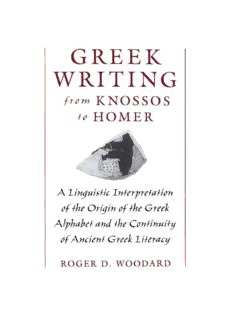
Greek Writing from Knossos to Homer: A Linguistic Interpretation of the Origin of the Greek Alphabet and the Continuity of Ancient Greek Literacy PDF
Preview Greek Writing from Knossos to Homer: A Linguistic Interpretation of the Origin of the Greek Alphabet and the Continuity of Ancient Greek Literacy
Greek W r i t i ng from Knossos to Homer This page intentionally left blank Greek W r i t i ng f r om Knossos to H o m er A Linguistic Interpretation of the Origin of the Greek Alphabet and the Continuity of Ancient Greek Literacy ROGER D. WOODARD New York Oxford Oxford University Press 1997 Oxford University Press Oxford New York Athens Auckland Bangkok Bogota Bombay Buenos Aires Calcutta Cape Town Dar es Salaam Delhi Florence Hong Kong Istanbul Karachi Kuala Lumpur Madras Madrid Melbourne Mexico Cily Nairobi Paris Singapore Taipei Tokyo Toronto and associated companies in Berlin Ibadan Copyright (n 1997 by Roger D. Woodard Published by Oxford University Press, Inc. 198 Madison Avenue, New York, New York 10016 Oxford is a registered trademark of Oxford University Press All rights reserved. No part of this publication may be reproduced, stored in a retrieval system, or transmitted, in any form or by any means, electronic, mechanical, photocopying, recording, or otherwise, without the prior permission of Oxford University Press. Library of Congress Cataloging-in-Publication Data Woodard, Roger D. Greek writing from Knossos to Homer : a linguistic interpretation of the origin of the Greek alphabet and the continuity of ancient Greek literacy / by Roger D. Woodard. p. cm. Includes bibliographical references and index. ISBN 0-19-510520-6 1. Greek language—Alphabet. 2. Written communication—Greece—History. 3. Language and culture—Greece—History. 4. Greek language—Written Greek. 5. Literacy—Greece— History. 6. Greek language—Writing. I. Title. PA273.W66 1997 481M— dc20 96-7447 9 X 7 6 5 4 3 2 1 Printed in the United States of America on acid-free paper This page intentionally left blank P r e f a ce Of the many splendid achievements of the ancient Greeks, the alphabet was perhaps the most marvelous and certainly the most influential. Like practically all great intellectual and technological achievements, this one was no creation ex nihiio. The alphabet stands on the shoulders of the consonantal script of the Phoenicians, as is well known. However, in the following pages I argue that one alphabetic foot also rests on a shoulder of the syllabic script of the Cypriot Greeks. That this is so only comes to light when the question of the origin of the alphabet is examined in a manner which cuts across individual disciplinary boundaries. Because of the cross-disciplinary nature of this investigation, some of the territory traversed will be unfamiliar to one or another group of readers. The phonetic and phonological discussions and the careful examinations of ear- lier attempts to elucidate certain spelling strategies of the Greek syllabaries will, for example, be new ground for some. These matters are, however, crucial in discovering that there is indeed a continuum of Greek literacy from Mycen- aean Knossos to Homer. Perhaps those readers less familiar with linguistics may even wish to begin reading the book with chapter 6 and, after complet- ing chapter 8, go back and read the book from the beginning. Readers may also wish to consult the phonetic glossary and charts which appear following chapter 8. This is a work which has taken shape over some time. While I would hesi- tate to provide an exhaustive list of everyone who has offered constructive comments along the way, lest some individuals be unintentionally omitted, there are particular persons and organizations to whom I must express heartfelt appreciation. 1 am yet again deeply grateful to the Andrew W. Mellon Founda- tion, which provided partial support for the research underlying this book. I would like to express my appreciation to Marshall Cohen, former dean of the Humanities Division of the College of Letters, Arts and Sciences at the Univer- viii Preface sity of Southern California, for granting to me a semester's leave during a critical stage in the writing of this book. For reading the manuscript and offer- ing guidance and encouragement, I particularly thank Professors Thomas Pa- laima, Laurence Stephens, and William Thalmann. For his assistance with Rus- sian language and many kind suggestions, I am most grateful to my former Johns Hopkins colleague and friend, the late Professor James W. Poultney. I am deeply indebted to Oxford University Press and to Elizabeth Maguire, Elda Rotor, Susan Chang, Rahul Mehta, and Robert Dilworth for the wonderful edi- torial assistance which they have provided. Last and most importantly of all, I thank my wife and son for their unfailing support, without which this undertak- ing could not have come to fruition. Whatever errors and oversights remain herein are solely my own. C o n t e n ts Abb re ν ia lions xiii 1 / Introduction J 1.0 Overview 3 1.3 The Greek Syllabaries 4 1.2 Miscellanea 6 2 / The Syllabaries 8 2.0 Structure of the Syllabaries 8 2.0.1 Symbol Types 8 2.0.2 ill-Suited Systems 9 2.0.3 Linear Β 10 2.0.4 The Cypriot Syllabary 11 2.0.5 Final Clusters in Linear Β 12 2.0.6 Geminate Clusters 13 2.0.7 Word-Initial Clusters 13 2.0.8 Summary of Spelling Strategies 13 2.0.9 Other Orthographic Practices 14 2.1 Previous Accounts 15 2.1.1 Linear Β 15 2.1.2 The Cypriot Syllabary 15
Description: